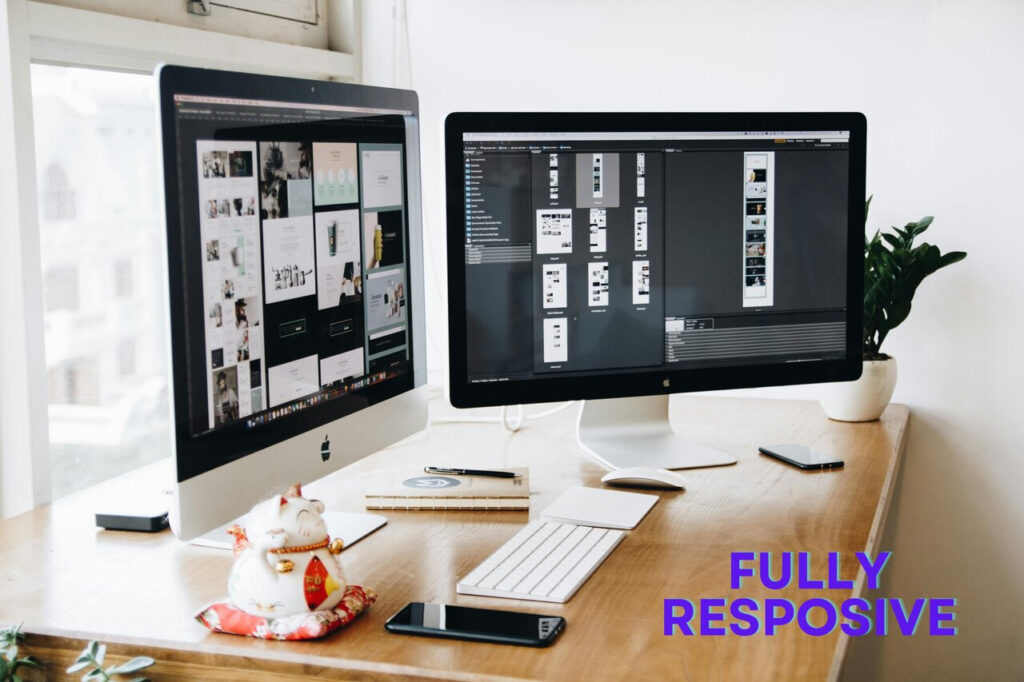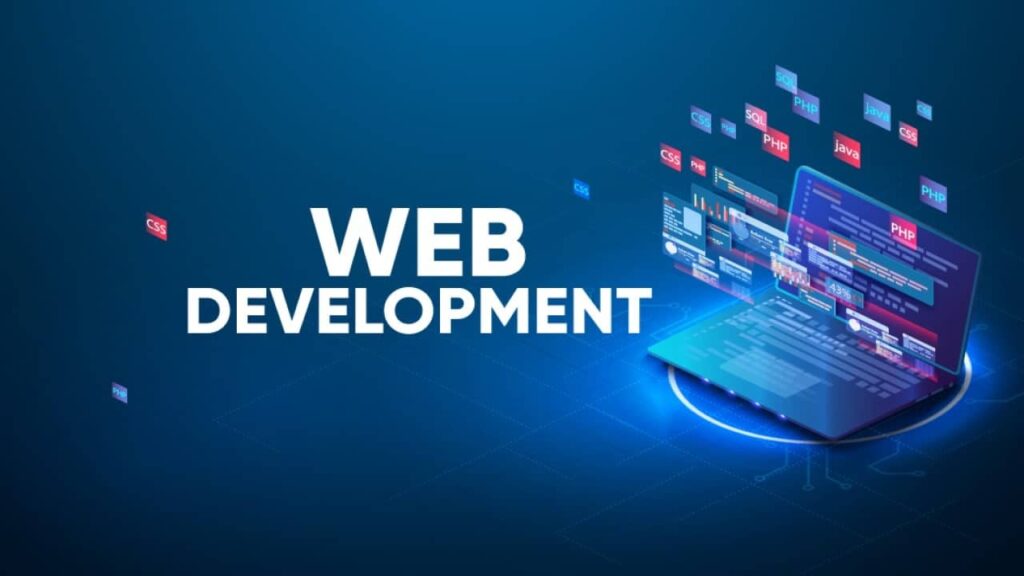The digital revolution is rapidly changing how regions attract businesses and investors. The internet has become a key driver of economic growth, and a strong online presence is more important than ever. Your economic development website is your digital storefront, showcasing your region’s potential and opportunities to a global audience.
Table of Contents
What is economic development website design?
Economic development website design refers to the process of creating a website specifically tailored to promote and support economic growth within a region or community. These websites typically include information and resources aimed at attracting businesses, investors, entrepreneurs, and skilled workers to the area.
Your economic development website design is like a magnet, and its design is the key to attracting businesses. To truly connect with your audience and drive results, user-centric design is crucial. This means thinking about who will be visiting your site – investors, entrepreneurs, residents – and tailoring the experience to their needs.
Imagine user research as getting to know your audience. Surveys, interviews, and usability testing can reveal what people are looking for and what frustrates them. With this intel, designers can create clear navigation, strong calls to action, and user-friendly interfaces that make finding information a breeze.
Think of your economic development website design as a responsive friend – available on any device. Responsive design ensures your site looks great and functions smoothly on desktops, laptops, tablets, and smartphones. This not only makes things easier for visitors but also shows you care about accessibility, which creates a good first impression.

User-centric design principles for economic development website design
Let’s face it, text can get boring. Punch things up with videos, images, infographics, and interactive maps! These elements grab attention and turn dry information into something fun and easy to understand.
Imagine a video showcasing your region’s stunning landscapes, top-notch infrastructure, and vibrant cultural scene. Wouldn’t that get potential investors and visitors excited? Interactive maps can highlight key features like amenities, business districts, and development opportunities, giving users a clear picture of what your region offers.
Infographics are like data superheroes – they transform complex statistics into clear, visually appealing graphics that people can easily understand and share. By presenting information in an engaging way, your website can spark deeper interest, encourage exploration, and leave a lasting impression.
Integrating multimedia elements to enhance engagement
Economic development website design is all about creating a holistic experience. Prioritize user needs, embrace responsive design, and leverage multimedia elements to build immersive and impactful digital experiences. Websites that resonate with your audience and effectively communicate your region’s value will be the driving force behind sustainable growth and prosperity.
The Winning Formula: Essential Elements for Your Economic Development Website Design
To build a successful economic development website, you need to cater to different stakeholders, keep them engaged, and encourage collaboration. Here’s the winning formula:
- Data Powerhouse: A central data hub is key. This means offering relevant and up-to-date information like demographics, workforce stats, industry profiles, and economic indicators. Think user-friendly – make it easy to find and explore this data! With reliable information at their fingertips, businesses and investors can make informed decisions about expanding or relocating to your region.
- Business Booster Resources: Your website should be a one-stop shop for businesses of all sizes. Offer resources like information on incentive programs, financing options, permitting processes, and industry-specific support services. By making this information clear and accessible, you’re creating an environment that encourages entrepreneurship and innovation. Imagine a small business owner finding guidance on permits or a tech startup discovering funding opportunities – your website can be their secret weapon!
- Community Connection Hub: Don’t just be a data dump – become a community hub! Interactive features like forums, discussion boards, and social media integrations let people connect, share ideas, and participate in local initiatives. This fosters a sense of belonging and ownership among residents, businesses, and community organizations. Think of it as a digital town hall – a place to discuss development projects, promote local events, and celebrate achievements together. Engaged stakeholders are invested stakeholders, and that’s the key to a thriving regional economy.
Building a successful economic development website is about creating a platform with comprehensive data, valuable resources, and interactive features that empower stakeholders, drive collaboration, and pave the way for lasting growth. By focusing on these key elements, your website can become the engine that propels your region’s economic success.
Making Your Mark: Best Practices for High-Impact Economic Development Website Design
The digital world moves fast, and economic development website design need to keep pace to make a lasting impression. Here are some best practices to ensure your website gets noticed and delivers results:
- Mobile First: Smartphones and tablets are everywhere, so your website must be mobile-friendly. This means it needs to adapt and look great on any screen size. Think of it as providing a comfortable browsing experience, no matter what device someone uses. Mobile responsiveness isn’t just a trend – it’s essential for reaching a wider audience and showing you care about user satisfaction. After all, potential investors or entrepreneurs might be checking out your region on their phones while traveling!
- SEO Savvy: In today’s online world, getting found in search engines is crucial. SEO (Search Engine Optimization) is like speaking the language search engines use to rank websites. By using the right keywords, optimizing content, and keeping things up-to-date, you can improve your website’s visibility and attract qualified visitors. Imagine potential investors searching for “business opportunities” – with strong SEO, your website could be the first thing they see!
- Fresh Content is King: The economic development landscape changes, so your website shouldn’t be a relic of the past. Regular updates keep your content fresh, your security tight, and your website functioning smoothly. Think of it as maintaining a well-oiled machine. Regular maintenance also allows you to gather valuable user feedback and website analytics. This information is gold – it helps you understand what’s working and where you can improve, making your website even more impactful.
By following these best practices, you can design an economic development website that grabs attention, drives traffic, and becomes a powerful tool for growth and prosperity in your region. Remember, your website is a dynamic platform – keep it fresh, keep it optimized, and watch it become a magnet for businesses and investors.
Investor Matchmaker: How Your Economic Development Website Design Can Attract Investment
Attracting investors goes beyond old-school methods. Economic development website design can be powerful tools to showcase your region’s strengths and lure in investment dollars. Here’s how:
- Highlight What Makes You Shine: Your website should be a virtual brag board for your region! Showcase your unique assets, from top-notch infrastructure to a skilled workforce. Think interactive maps highlighting transportation networks and thriving business districts. Don’t forget quality of life – beautiful scenery can be a major draw for businesses looking to attract talent. Visually appealing imagery and engaging multimedia content can paint a vivid picture of what your region offers, grabbing investor attention and making them see the value of investing there.
- Content that Builds Trust: Great visuals are just the beginning. You also need content that makes investors feel confident about putting their money in your region. Provide clear information on investment incentives, tax breaks, and regulations – these are all factors businesses consider. Success stories and testimonials from existing investors are gold – they show a track record of success and highlight the benefits of investing in your region.
- Transparency is Key: Investors don’t like surprises. Be transparent about the investment process, including permitting and regulations. Clear guidelines build trust and reduce uncertainty.
- Become an Industry Authority: Showcase your expertise! Publish thought leadership content, industry reports, and market analyses. This positions your region as a knowledge hub and innovation center, further boosting investor confidence.
By combining a visually appealing website with informative and engaging content, you can effectively communicate why your region is the perfect place to invest. Remember, your website is an investment magnet – use it to attract businesses and fuel sustainable economic growth.
The Power of Story: Captivating Your Audience for Economic Growth
Forget dry statistics and policy jargon – economic development is all about telling a compelling story. Stories connect with people on a deeper level, and that’s what you need to do with stakeholders in your region.
- Your Region’s Unique Story: Storytelling goes beyond facts and figures. It’s about creating meaning and showcasing what makes your community special. Think about your region’s history, culture, and goals. Share the stories of local entrepreneurs, celebrate community achievements, and highlight innovative projects. By weaving these narratives, you paint a picture of a vibrant place to live, work, and invest.
- Building Emotional Bridges: Stories aren’t just informative, they’re emotional. By tapping into themes of hope, perseverance, and progress, you can connect with stakeholders on a personal level. Show the human side of economic development – the local business owner chasing a dream, the community project making a difference, or the individuals who’ve thrived in your region. These stories make complex economic concepts relatable and show the real impact of your initiatives.
- Stakeholders Become Storytellers: Don’t just tell your story, get everyone involved! Testimonials, community forums, and participatory storytelling initiatives can empower people to become advocates for change. When stakeholders feel like they have a voice and a stake in the future, they become more invested in the region’s success. This sense of ownership fuels collective action and paves the way for lasting progress.
By harnessing the power of storytelling, you can create a more human connection with stakeholders, inspire action, and build a community that thrives together. Remember, economic development isn’t just about numbers – it’s about the people and the stories that shape your region’s future.
The Talent Hunt: Attracting and Keeping the Best
A skilled workforce is the key to growth and innovation. Economic development organizations can be talent magnets, attracting and keeping the best people around. Here’s how:
- Jobs Galore, Careers to Explore: People want opportunity. Economic development organizations can be a one-stop shop for job seekers. Partner with businesses and schools to list open positions, industry trends, and skills needed. This way, talented people can find jobs that match their goals and interests. And it doesn’t stop there – offer resources for training and upskilling so people can build rewarding careers in your region.
- More Than Just a Paycheck: It’s not all about work! Quality of life is a major draw for talented people. Showcase what makes your region special – beautiful parks for outdoor adventures, a thriving arts scene, great schools for families, and affordable housing options. Use websites, social media, and community events to paint a picture of a place where people can live, work, and play to their fullest.
- Happy Work, Happy Life: People want a good work-life balance. Show that your region supports that! Highlight initiatives like flexible work arrangements, childcare assistance, and wellness programs. By demonstrating a commitment to well-being, you’ll attract talent who want to be happy at work and at home.
By becoming a talent magnet, economic development organizations can create a thriving environment that fuels innovation and economic growth. Remember, talented people are looking for opportunity and a great place to live – your region can offer both!
Small Town, Big Online Presence: Building a Economic Development Website Design on a Budget
Even small communities need a strong website to thrive. But let’s face it, budgets can be tight. Here’s the good news: creating a great website doesn’t have to break the bank!
- DIY Website Builders: Forget fancy coding! Website builders like Wix, Squarespace, and WordPress offer pre-designed templates and user-friendly tools. These platforms are affordable and don’t require a tech degree, so you can build a professional-looking website yourself.
- Open-Source Options: Feeling tech-savvy? Open-source software like Joomla or Drupal gives you free access to powerful website building tools and tons of customizable templates. This is a great option for building a dynamic website that fits your specific needs, without a hefty price tag.
- Content is King: A great website isn’t just about looks, it’s about valuable content. Invest your time in creating informative articles, blog posts, and local news that people are interested in reading. This will establish your community as a trusted source of information and attract visitors naturally.
- SEO Savvy: Search Engine Optimization (SEO) helps people find your website online. There are free resources to learn about SEO basics, like using relevant keywords and building good links. By optimizing your website, you’ll ensure it shows up in search results when people are looking for information about your community.
- Social Media Buzz: Get social! Promote your website and connect with residents and potential visitors on Facebook, Instagram, or other social media platforms. Engaging with people online can drive traffic back to your website and build a sense of community.
- Team Up: Building a website doesn’t have to be a solo act. Partner with local businesses, organizations, or even volunteers! Maybe a design student can offer pro bono services, or a local writer can create content. By working together, you can leverage existing resources and keep costs down.
Remember, a small budget doesn’t mean a small impact. By being creative and strategic, you can build a website that showcases your community’s unique spirit, attracts visitors, and fuels economic growth. So get out there and start building!
Making Your Website Work Harder: Tracking Success with KPIs
You need to know if your economic development website is working. That’s where Key Performance Indicators (KPIs) come in – they’re like scoreboards that track how well your website is doing.
- Website Traffic: Counting Visitors: This is a big-picture KPI – it shows how many people are visiting your website. Think of it as understanding how many people walked through the door of your local visitor center. The higher the traffic, the wider your reach.
- Engagement Matters: Not all visitors are created equal. Engagement metrics like bounce rate (people who leave right away), time spent on the site, and how many pages they visit tell you if people are finding your content interesting. The goal is to keep them engaged and exploring!
- Conversions: Taking Action: This is where things get exciting! Conversion rates track how many visitors take the actions you want them to take, like filling out contact forms, downloading resources, or signing up for newsletters. High conversion rates mean your website is turning visitors into leads for businesses and investors.
Data That Drives Decisions:
Looking at website data isn’t enough, you need to understand what it means. Analytics tools like Google Analytics give you deep insights into who’s visiting your site, where they come from, and what interests them. This goldmine of information helps you:
- Know Your Audience: By understanding demographics, you can tailor your content and messaging to resonate with the people you’re trying to reach. Imagine speaking directly to potential investors instead of giving a generic presentation.
- Smart Marketing: See where your website traffic comes from? This helps you focus your marketing efforts on the channels that drive the most visitors. Stop wasting resources on things that don’t work!
- Test and Improve: Ever wonder if changing a button color or layout would make a difference? With A/B testing, you can try out different website elements and see what works best for user engagement and conversions. It’s all about constantly refining your website based on real data.
By tracking KPIs and analyzing data, you can turn your economic development website into a powerful tool for attracting investment, fostering growth, and achieving your economic development goals. Remember, your website is a work in progress – keep testing, keep learning, and keep making it better!
Local Business Spotlight: How Economic Development Website Design Help Businesses Thrive
Economic development websites aren’t just about attracting big investors – they’re a game-changer for local businesses too! Here’s how:
- Get Seen, Get Customers: Economic development websites are like online phone books for local businesses. They list businesses in directories, making them easy to find for potential customers, investors, and collaborators. Think of it as free advertising to a wider audience! These websites even feature success stories and profiles that showcase the achievements of local businesses, further boosting their reputation and attracting even more attention.
- Resources at Your Fingertips: Need help navigating the maze of starting or running a business? Economic development websites offer a treasure trove of resources. This could be anything from info on permits and licenses to finding funding and grants, or even mentorship programs and training opportunities. It’s a one-stop shop for support and guidance, empowering business owners to focus on what they do best – running their businesses!
- Collaboration is Key: These websites aren’t just bulletin boards – they’re community hubs! Online forums, discussion boards, and networking events connect local businesses with each other. Imagine sharing ideas and best practices with your peers, or even finding partners for joint ventures. This kind of collaboration strengthens the entire local business community, making it more resilient and adaptable in the face of challenges.
By empowering local businesses, economic development websites create a thriving economic ecosystem that benefits everyone. It’s a win-win for businesses, investors, and the community as a whole.

Real Stories, Real Impact: How Economic Development Website Design Make a Difference
In the world of economic development website design, success stories are like inspiring movies. They show real communities using websites to achieve amazing things. By sharing these stories, we can all learn from each other’s wins.
- Show Me the Money (and Jobs): Imagine a small town using their website to attract new businesses, creating jobs and breathing new life into the local economy. That’s the power of a great economic development website! Case studies showcase these real-world examples, highlighting different approaches that work. Maybe a city website boosted tourism, bringing in more visitors and helping local businesses thrive. These stories show the variety of ways websites can make a positive impact.
- Learning from the Best: Case studies aren’t just about bragging rights. They offer valuable lessons for everyone. By analyzing successful websites, we can see what works. For instance, a case study might highlight the importance of making the website easy to use on any device (phone, tablet, computer), or how clear navigation keeps visitors engaged. They might also show the power of creating high-quality content, getting ranked high in search results, and using social media to spread the word.
- Teamwork Makes the Dream Work: Building a successful economic development website isn’t a solo act. Case studies often highlight the importance of collaboration. Maybe local businesses, government agencies, and residents all worked together to create a website that reflects the community’s goals. These stories show us that everyone has a role to play, and working together creates a website that truly represents the community it serves.
Sharing success stories and case studies isn’t just about inspiration, it’s about learning and growing together. By seeing what others have achieved, economic development organizations can create websites that make a real difference in their communities.
Crystal Ball Time: What’s Next for Economic Development Websites?
The tech world is moving fast, and economic development websites are along for the ride! Here’s a glimpse into the exciting future:
- Smarter Websites, Happier Users: Imagine a website that can answer your questions and guide you like a helpful assistant. That’s the power of Artificial Intelligence (AI)! Websites are getting smarter, using AI to personalize the user experience and provide real-time support.
- Welcome to the Future! Forget flat pictures – virtual reality (VR) and augmented reality (AR) are bringing websites to life. Imagine taking a virtual tour of a business park, or seeing development plans come to life with AR. These technologies will let people experience a place before they even visit.
- Websites for Everyone: Accessibility is key! New tech like voice search and natural language processing (NLP) will make websites easier to use for everyone, no matter their abilities. Imagine talking to your website to find information, or having it understand your questions in plain English.
- Going Green, Growing Strong: The future is sustainable! Economic development is shifting towards attracting businesses that share a focus on protecting the environment and social responsibility. Websites will reflect this shift, showcasing communities that are committed to a greener future.
- Location Independent Living: The ability to work remotely is changing everything. Communities with great internet and digital infrastructure will be magnets for remote workers and entrepreneurs seeking a flexible lifestyle. Economic development websites will become hubs for attracting this new wave of residents.
- Data is King: In the future, decisions will be based on hard facts, not hunches. Economic development organizations will use data analytics to understand what’s working and what’s not. This will help them make smarter choices about attracting investment and creating jobs for their communities.
By staying ahead of the curve and embracing new technologies, economic development websites can become powerful tools for building vibrant and thriving communities in the digital age. The future is bright!
Conclusion
A strong online presence is essential for any community that wants to thrive. Economic development websites are like digital front doors, welcoming potential investors, businesses, and even new residents.
Websites that Work: A Recap
We’ve talked about a lot, but here’s the gist: a well-designed economic development website can be a game-changer.
- Telling Your Story: Imagine a website that paints a picture of a place – its people, its spirit, its potential. That’s the power of storytelling! Websites can attract investment and businesses, but they can also build local pride and get residents excited about the future.
- The Talent Hunt: A good website can be a magnet for skilled workers. By showcasing job opportunities, career paths, and the cool things a place has to offer (think great schools, outdoor adventures, or a thriving art scene), websites can attract and retain the talent a community needs to grow and innovate.
- Smart Design, Small Budget: The good news? Even communities with limited resources can create impactful websites. There are affordable options like website builders and open-source software, and partnerships can help stretch your budget even further.
- Tracking What Works: Data is king! Websites with analytics tools can track how many people visit, how long they stay, and what they’re interested in. This information is gold – it helps economic development organizations understand what’s working and what needs improvement.
- Helping Local Businesses Thrive: Websites can be a powerful tool for local businesses. Imagine a central location where businesses can list themselves, share their stories, and connect with potential customers. Economic development websites can do all that and more, fostering collaboration and growth within the local business community.
- Learning from Success Stories: Sharing success stories is inspiring! By showcasing real communities that have used websites to achieve amazing things, we can all learn from each other’s wins.
Economic development websites aren’t just about today – they’re about the future too. By embracing new technologies like artificial intelligence (AI), virtual reality (VR), and data analytics, economic development organizations can keep their websites on the cutting edge. For more knowledge on website design check our other blogs!




